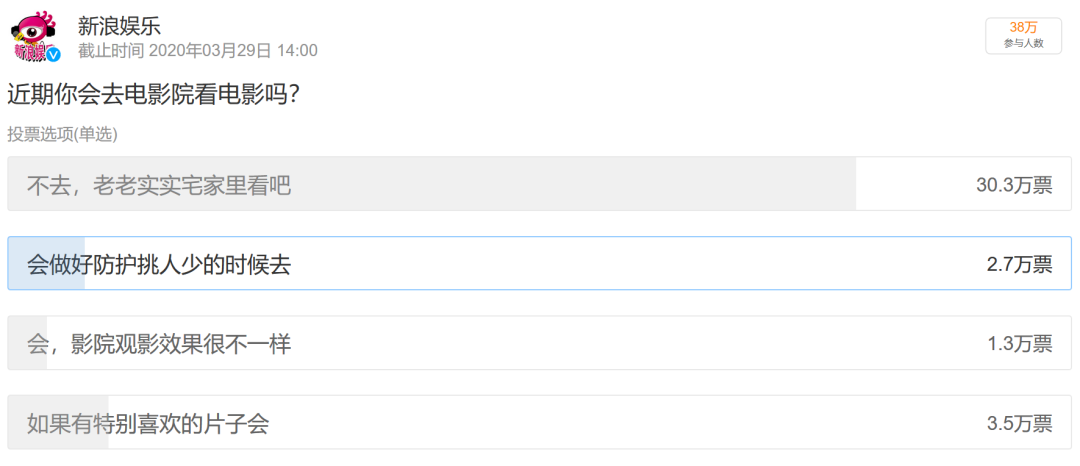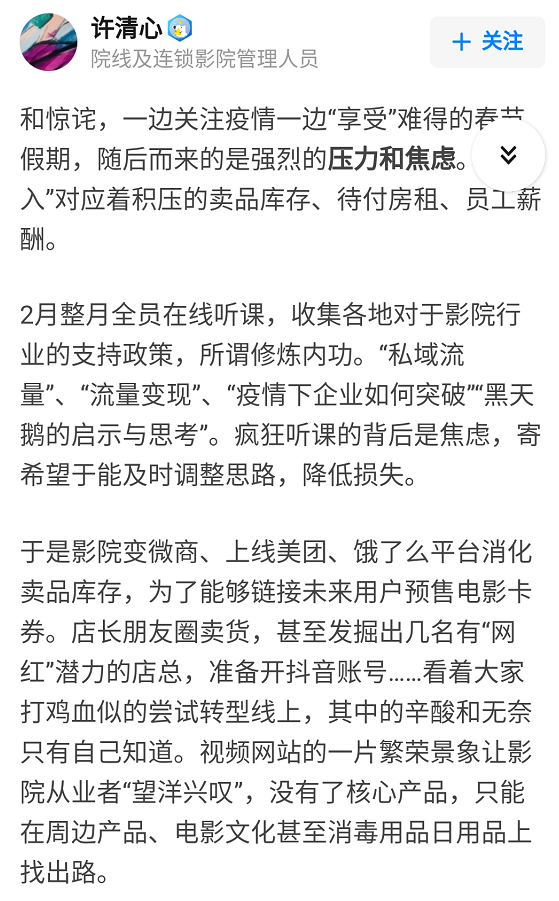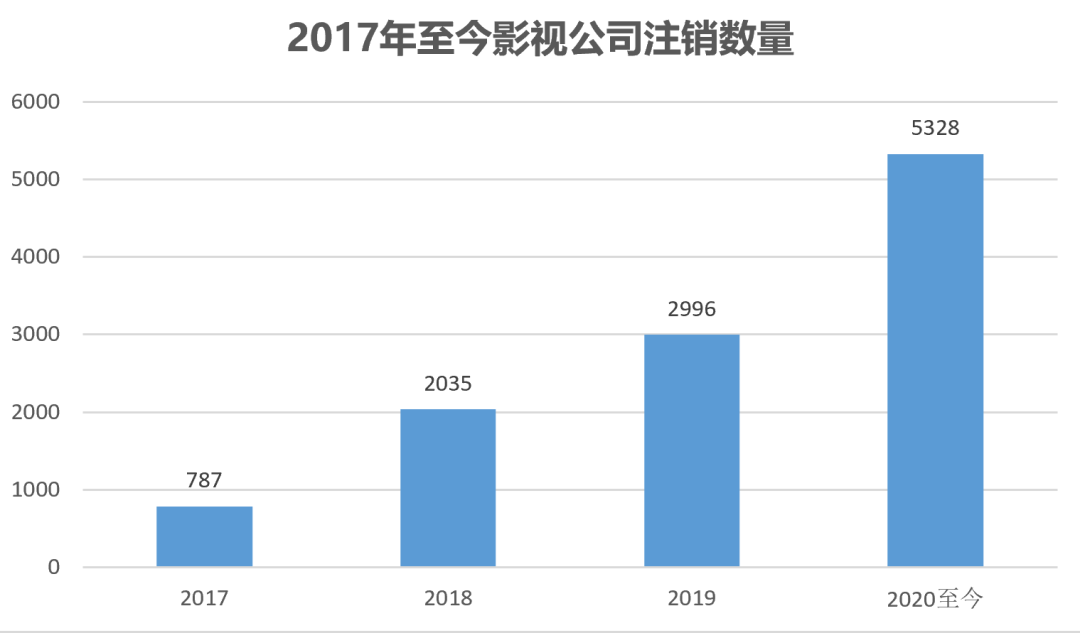No theater is easy, and no theater is better.
Editor’s note: This article is from WeChat public account “ Mirror Entertainment ” (ID: jingxiangyule ), author: Pang Li Jie, editor: Li Qian snow.
It’s too difficult to resume the theater!
On March 27, Xinhua Daily News’s meeting point news was informed by the Provincial Film Bureau that, following the notification of the National Film Bureau, all theaters are temporarily closed, and operations have been suspended immediately. The specific resume time will be notified by the National Film Bureau. From the resumption of work to the suspension of work, but after a period of ten days, the theaters that had been gradually reopened before were closed again.

From the feedback from netizens, most netizens support that theaters will not resume business for the time being. The impact of the epidemic has not yet passed, the consumer market’s confidence in watching movies has not recovered, and the time for movie theaters to resume work has not yet matured.

Beacon data show that from March 16 to March 22, 529 theaters in Mainland China opened, with a return rate of 4.8%. The overall performance is not optimistic. Taking March 22 as an example, the total number of resumption theaters on that day reached 1,389, while the number of moviegoers was only 1,326, and the average number of moviegoers was less than one.
Although the domestic epidemic has been basically controlled,Next, theaters, film and television companies, theater lines, and the consumer market are not really ready to resume work.
Stop work after resumption of work: 80% of netizens refuse to watch movies
Cinema is not like the catering industry. It has strong individual mobility. The content output of the theater must ensure that it is screened nationwide. Under the epidemic, theater resumption is periodic, especially in the early stage of resumption, it is difficult to open the situation.
At present, the cinema has fallen into a “strange circle” of resumption of work: periodic resumption of work, low initial resumption rate → insufficient consumer confidence in movie viewing → theaters set interval movie viewing, preferential policies, regular disinfection, higher costs → small benefit space Cannot be released → The resumption theater is mainly based on high-quality movies. The content is not very attractive, and the attendance rate is low.
From this “strange circle”, we can see that there are two key factors affecting the resumption of theaters at present: one is that consumers are not ready to return to the cinema to watch movies, and the other is that rescreened films have lost their movie content The advantages of the theater’s starting line and window period, coupled with the impact of the epidemic, can be seen at home, and there is almost no need to enter the theater. The new films, especially the heavy-weight films, will not choose to enter at this time due to the high cost of investment, which greatly reduces the attractiveness of the content delivered by the theater.
Reflecting the netizens ’willingness to watch movies, a poll data launched by Sina Entertainment on Weibo also showed that as of press time, the audience who chose not to go to the cinema to watch movies reached 303,000, accounting for nearly 80%. In addition, audiences who are willing to enter the theater for content that they particularly like, although second only to the former, account for less than 10%.

Consumer market outlook The film confidence has not been fully restored after the hit, and even if the theater resumes work, it is difficult to have enough income to maintain operation.
Cat’s Eye Professional Edition data shows that on March 27, among the 194 theaters counted by the platform, more than 50 theater box office zero incomes, and more than 80 theater box office incomes were below 100 yuan.

Income is hard to secure, but spending is growing. In addition to basic costs such as water, electricity, labor, and rent, theaters also need to bear extra costs for a “non-toxic environment.” Especially the air-conditioning system of the theater needs professional disinfection. According to the professional disinfection company’s quotation, the full disinfection cost of the 2000-3000㎡ cinema is about 5000-6000.
The movie theaters cannot make ends meet, which will continue to affect the return to work efficiency for a period of time.
Cat’s Eye Professional Edition data shows that on March 24, there were 495 theaters resumed, which was 43 fewer than the previous day. The negative growth means that the theaters that have resumed work have stopped working again. This phenomenon is still continuing. On March 26, only 140 theaters nationwide were open, compared with more than 400 the day before. Over 300 theaters have been shut down in three days. Now, the theaters have been resumed. Was stopped.

The sluggish consumer market ’s confidence in movie viewing has affected the confidence of returning to the theater. In the future, in addition to helping consumers rebuild their confidence from the content and publicity perspective, the market also needs to help the theater from capital support. Regain confidence.
Just alive: More than 2200 cinema companies have fallen
The theater was shut down on a large scale, and “self-help” has become the only option in the industry.
Since the outbreak of the epidemic, theaters in various places have turned into “micro-businesses”, binding movie coupons to sell popcorn and beverages on platforms such as Friends Circle, Meituan, and Hungry; and some businesses have successively released notices of rent reductions. The theater reduced wages and even suspended wages for employees, reducing the pressure on the survival of the theater; on March 17, China Film released a notice saying that it would give 100% of the box office generated by its re-release movies to the theater.
The industry is actively seeking survival space under difficult circumstances.
A netizen who knows to be certified as a “Cinema and Chain Theater Manager” wrote: “All members took online lessons throughout the month of February to collect support policies for the theater industry in various places, so-called internal practice.” In the process of digesting the inventory of selling goods, even the theaters began to try to transform online: “Explore a few” net red “potential store staff, ready to open a vibrato account.”

In 2019, the total box office in the Mainland was 64.266 billion yuan, a year-on-year increase of 5.4%, and the total number of moviegoers reached 1.727 billion, a year-on-year increase of 0.64%; while the number of new screens nationwide reached 9,708, a year-on-year increase of 16%. By comparison, the growth rate of domestic screens is much higher than the growth rate of moviegoers, the industry’s resource utilization efficiency is not high, and there is a huge risk of loss.
The same is true. Iqiyi CEO Gong Yu has publicly stated that in the first quarter of 2019, the average attendance rate of movie theaters in the country was only 12%, and about half of the movie theaters were losing money. More importantly, the situation of loss has long been the norm. According to relevant data, in the four years from 2014 to 2018, over 60% of the cinemas had less than 5 million box office sales, and 90% of the cinemas were not profitable.
Under such a development environment, the epidemic has become the last straw that has crushed many theaters. According to the data of SkyEye Professional, as of February 29,In the first two months of 2020, fewer than 8,000 cinema companies will be added. Compared with the same period in 2019, the number of new cinema companies in China will fall by 25%.
At the same time, the number of cancellations for cinema companies has also increased year by year since 2012, and the number has increased significantly in 2015. Among them, the number of cancellations in 2019 is the highest, reaching more than 18,000. In 2020, as of March 27, 2,263 theater-type companies had been cancelled.
Today, the resumption of theaters is blocked, and the trend of industry losses will continue, which means that more theaters will not be able to withstand the “cold winter” in the future. Moreover, the obstruction of the downstream content output also quickly spread to the upstream, coupled with the low rate of resumption of work in the entertainment industry, many film and television companies have not been able to insist on the arrival of “spring”.
According to company search data, since 2020, 5328 companies engaged in film and television related companies have been cancelled or revoked, which is 1.78 times the number of film and television companies cancelled / revoked in 2019.

The dilemma of the theater is intensifying: Integration is an internal concern.